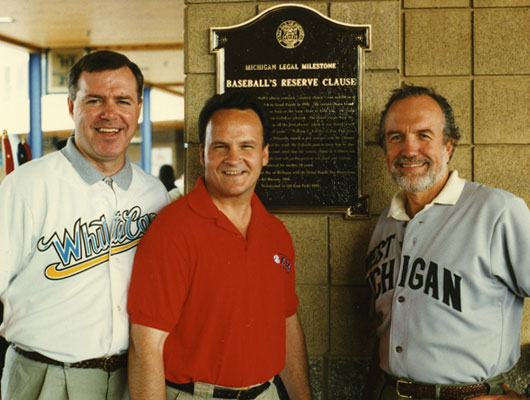Michigan Legal Milestones
2. Baseball's Reserve Clause

A 1914 decision in a Grand Rapids courtroom "bound a player to his team for as long as the team chose to keep him." Dedicated and placed at the Grand Rapids Art Museum, 1986. Rededicated and placed outside on June 20, 1996, at Old Kent Park (West Michigan Whitecaps Minor League Baseball stadium), Grand Rapids.
Resources
Stereoscope Magazine: The Catcher, the Quick Lunch King, and Baseball's Reserve Clause: Major League Litigation in Grand Rapids, Winter 2003
Baseball's Reserve Clause, Speech by Dennis W. Archer to the Michigan Supreme Court Historical Society, April 13, 2000
New York Times: Baseball Reserve Clause is Legal, January 31, 1914
Complete Text on Milestone Marker
Baseball's Reserve Clause
Organized baseball's player contract "reserve clause" was upheld in a federal court case decided in Grand Rapids in 1914. The reserve clause bound a player to his team for as long as the team chose to keep him. He could not play anywhere else unless traded or released. The object was to keep the wealthiest teams from signing all the best players, which it was feared would destroy America's "national game."
William F. Killifer of Paw Paw, star catcher for the Philadelphia Nationals, signed a new contract with the Chicago Federals. When he changed his mind, the Federals sued to force him to play for them. They lost. The court ruled that the reserve clause in Killifer's old contract giving the Nationals first call on his services was legal and binding. The reserve clause was enforced for another 50 years.
Placed by the State Bar of Michigan with the Grand Rapids Bar Association at the Grand Rapids Art Museum, 1986. Rededicated at Old Kent Park, 1996.